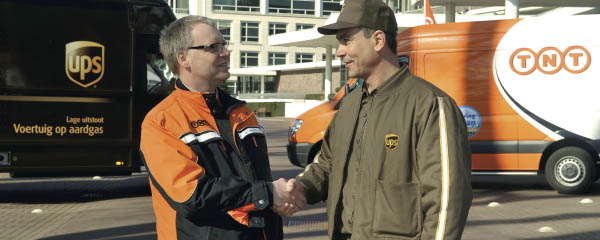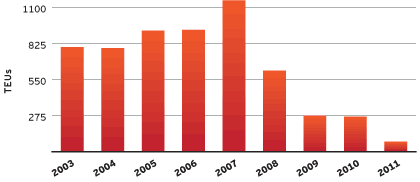Global Logistics—April 2012

UPS Buys TNT Express, Shifting Global Balance
UPS’ estimated $6.77-billion acquisition of Netherlands-based TNT Express puts to rest lingering speculation about the future of Europe’s number-two express mail provider following competition from FedEx and U.S. economic uncertainties. The move clearly places UPS in a new position of strength among its U.S. competitors and German expediter DHL as it looks to expand its presence in Europe and around the world.
UPS quantified the acquisition by stating that TNT’s intra-Europe road and rail freight network will expand its logistics solutions in Europe and provide North American customers with end-to-end service capabilities to that market. At the same time, European shippers will have similar access to the United States, Canada, and Mexico.
But the greater intrigue is how this new juggernaut deepens the footprint of UPS and its subsidiaries in fast-growing regions such as Asia-Pacific and Latin America.
For the past few years, TNT has been solidifying its Southeast Asian delivery system. Its integrated and branded Asian Road Network, which debuted in 2005, links China with more than 125 cities across 3,100 miles in Vietnam, Thailand, Singapore, Malaysia, and Laos. A $20-million regional hub in Singapore serves as a feeder into this growing intra-Asian lane. As manufacturing costs and consumer inflation continue to push China’s offshore interests and global companies in new directions, Southeast Asia is an obvious beneficiary. So is Brazil, where TNT has made similar inroads.
One challenge for global shippers and service providers is having assets and expertise on the ground—in lieu of relying on unreliable local resources—so they can allay risk and increase responsiveness. TNT provides this ready-made mix of infrastructure and resources. Still, its Chinese and Brazilian operations have underperformed, which likely contributed to the delay in sale, and now raises questions as to the viability of these other interests beyond Europe.
“While TNT has businesses in Brazil and Southeast Asia/China, they do not appear to be in good shape,” says Thomas Cullen, senior analyst for Transport Intelligence, a European logistics market consultant. “Brazil, in particular, seems to have severe problems. It will be interesting to see what UPS does with the Asian road freight business, as it has attempted to enter this market before.”
Bringing TNT into the fold now places UPS in direct competition with Deutsch Post’s DHL Express business in the European market—a reversal of fate after the German conglomerate’s failed effort to capture market share in the United States with the DHL brand. Given Europe’s current financial circumstances, UPS may see an opportunity to seize more than its “new” one-third share of the package delivery market with a competitive product and new value proposition.
UPS currently derives about 26 percent of its sales from outside the United States, according to financial services firm Stifel Nicolaus. That is expected to grow to 36 percent with the TNT buy, and reach 50 percent in the next five years. UPS competitors in both the expedited delivery and logistics sectors will probably feel pressure to respond.
“I can’t see DHL doing anything, but FedEx must be considering its options,” notes Cullen. “The only problem is that FedEx indicated it wasn’t interested in TNT—as did UPS.”
FedEx has since acquired Polish shipping company Opek, which gives it access to a domestic ground network worth about $70 million in annual revenue and 12.5 million shipments.
The extent to which this recent shake-up more broadly impacts global supply chains remains to be seen. With the U.S. economy beginning to show some signs of rebound, and Europe and parts of Asia now confronting their own domestic downturns, there is conjecture that more contraction is imminent. Rumors are circulating that $1-billion 3PL BDP International is on the market. Cullen sees this as a possibility, but believes the supply chain will find balance organically through further attrition.
“The purchase of TNT may be part of a trend in logistics sector consolidation, but I doubt if other areas such as shipping are too influenced by it,” he explains. “There has been an ‘oversupply’ of logistics companies in various sectors for many years now.”
Barring any regulatory or antitrust hiccups, the true impact of this swing in expedited delivery dominance will ultimately take time to materialize—after the European economy recovers and if, or when, TNT’s Southeast Asian and Latin American investments eventually mature under new direction.
Indian Godowns Grow Up
Simple storage godowns—or warehouses—in India are giving way to venture-funded logistics parks that are growing out to meet domestic consumption demand, according to a recent article by Indian newspaper Mint. This infrastructure transformation is part of sweeping modernization efforts throughout the country aimed at raising transportation and distribution standards, and improving performance.
Most Indian logistics parks are upgraded godowns or modern warehouses. A logistics park is generally differentiated by value-added services such as warehousing, cold storage, multi-modal transport, and the presence of an inland container depot or freight station.
The emergence of logistics parks is largely due to changes in the country’s taxation structure; fast growth in sectors such as automotive, mining, pharmaceuticals, and retail; and an increase in export-import trade and manufacturing activity. Companies are also driving greater efficiency and economy by consolidating facilities and activities, thereby reducing materials handling costs and speeding truck turns.
The investment of India’s vertically integrated businesses, such as Tata Group and Reliance Industries, is driving this current trend. But continuing development, and the government’s liberalization of trade and investment policies, will make the Indian market a much more attractive opportunity for foreign companies as well.
Franprix Food Deliveries Barge In
European shippers have historically relied on inland river transport as a conventional channel for distributing freight, but Franprix’s expectations are truly avant garde. The French supermarket plans to begin daily food deliveries to 80 stores in Paris via barge-intermodal.
Franprix will transport containers by truck from a warehouse in the Parisian suburbs to the inland port of Bonneuil-sur-Marne. It will then transfer the containers 12 miles by barge along the Marne and Seine rivers to the heart of the French capital—thus avoiding chronic road traffic congestion. Previously, services carrying food products by river to Paris had to terminate at ports in the suburbs due to the lack of a city center river terminal capable of handling containers.
Inland ports operator Ports de Paris has made the supermarket’s endeavor possible by creating a stretch of quayside in the city center that can accommodate barge shuttles. The service, which will be managed by France-based 3PL Norbert Dentressangle, is scheduled for launch in September 2012, beginning with 28 containers (the equivalent of 450 pallets) and eventually growing to 48 containers. Each container transported by river represents about 6,000 fewer truck miles annually.
Global Ocean Fleet Shrinks
What began in 2009 as a reactive measure to the U.S. economic downturn is now becoming standard operating procedure for the ocean freight industry. Steamship lines are starting to take containerships out of operation as rising fuel costs and falling freight rates threaten profitability, according to Maersk Line CEO Soren Skou.
About five percent of global container capacity—equivalent to 800,000 TEUs—is currently out of action. That figure could rise to one million TEUs in the near future.
Over the past decade, steamship lines have been locked in a tug-of-war over who has the biggest and best vessels. The looming reality of New Panamax containerships has only heightened competition.
But new vessel orders are flooding the market without a corresponding reduction in assets. In 2011, a peak season never materialized. Carriers introduced, then reduced, surcharges—and still ran well below capacity. Now shipping lines are reverting to 2009 measures and removing capacity entirely by laying up ships to artificially reduce costs, stimulate demand, and maintain rates. It’s no different from lean efforts elsewhere in the supply chain.
Maersk, the world’s largest container shipping carrier, posted a net loss of $505 million in 2011 and anticipates further losses in 2012. As a consequence, the carrier is committed to restoring profitability and reducing market overcapacity by adjusting its fleet and reducing vessel speed. Expect other carriers to follow suit.
Riding on the Marrakesh Express
Despite recurring political instability in the region, North Africa’s logistics star is on the rise—particularly on its far western coast in Morocco. The country is looking to set up 70 logistics hubs in Marrakesh, Casablanca, Tangier, Rabat, and Fes by 2020, as part of a long-term program to transform its supply chain capabilities.
North Africa plans to set up a national agency for logistics to steer the project, which forms part of an agreement between the government and the Confederation of Moroccan Industry aimed at making the country more globally competitive. In addition to creating a national network of hubs, the agency will also focus on expanding and optimizing traffic flows, attracting logistics talent, and managing regulatory governance.
One of the first hubs will be developed near the Port of Mohammedia, about 15 miles from Casablanca, where industrial developer GSE has secured a warehouse for Moroccan logistics firm SNTL.
U.S. Inbound TEUs from Iran
While U.S. imports from many countries have shown an increase over the past two years, imports from Iran have trended downward consistently since 2007. Due to recent debate, that will likely continue.
Source: Zepol Corporation

